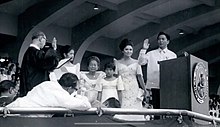
| ||
|---|---|---|
Related |
||
Ferdinand Marcos's second term as President of the Philippines began on December 30, 1969, as a result of his winning the 1969 Philippine presidential election on November 11, 1969. Marcos was the first and last president of the Third Philippine Republic to win a second full term.[1][2][3][4] The inauguration was at the Quirino Grandstand in Manila.[5] The inauguration marked the commencement of the second four-year term of Ferdinand Marcos as president and the third term of Fernando Lopez as Vice President. The oath of office was administered by Chief Justice of the Supreme Court of the Philippines Roberto Concepcion.
The end of Marcos's second term was supposed to be in December 1973, which would also have been the end of his presidency because the 1935 Constitution of the Philippines allowed him to have only two four-year terms.[6] However, Marcos issued Proclamation 1081 in September 1972, placing the entirety of the Philippines under Martial Law and effectively extending his term indefinitely.[7] He would only be removed from the presidency in 1986, as a result of the People Power Revolution.[8]
Marcos's first term, from 1965 to 1969, had been relatively successful, marked by industrialization, infrastructure development, and an increase in rice production. But in order to win his second term, which would be from 1969 to 1972, Marcos pursued a USD50 million spending spree on infrastructure projects meant to impress the electorate.[9] This rapid spending resulted in a balance of payments crisis, which led Mr. Marcos to seek an adjustment program from the International Monetary Fund, the conditions for which included a reduction of selected tariff rates and a 43 percent monetary devaluation.[10] The exchange rate plummeted from 3.9 Pesos to the U.S. Dollar in 1969 to 6 Pesos to the Dollar in 1970, leading to inflation, and eventually, general unrest.[11]
- ^ Timberman, David G. (1991). A changeless land: continuity and change in Philippine politics. Institute of Southeast Asian Studies. p. 63. ISBN 9789813035867.
- ^ Boudreau, Vincent (2004). Resisting dictatorship: repression and protest in Southeast Asia. Cambridge University Press. p. 7. ISBN 978-0-521-83989-1.
- ^ Hedman, Eva-Lotta E. (2006). In the name of civil society: from free election movements to people power in the Philippines. University of Hawaii Press. p. 70. ISBN 978-0-8248-2921-6.
- ^ McCoy, Alfred W. (2009). Policing America's empire: the United States, the Philippines, and the rise of the surveillance state. University of Wisconsin Press. p. 52. ISBN 978-0-299-23414-0.
- ^ Second Inaugural Address of His Excellency Ferdinand E. Marcos (Speech). Official Gazette of the Republic of the Philippines. December 30, 1969. Retrieved June 2, 2023.
- ^ "1935 Constitution, as amended". Official Gazette. Philippine government.
- ^ Francisco, Katerina (September 22, 2016). "Martial Law, the dark chapter in Philippine history". Rappler. Archived from the original on September 23, 2016. Retrieved June 29, 2018.
- ^ Duet for EDSA: Chronology of a Revolution. Manila, Philippines: Foundation for Worldwide People Power. 1995. ISBN 9719167009. OCLC 45376088.
- ^ Burton, Sandra (1989). Impossible Dream: The Marcoses, the Aquinos, and the Unfinished Revolution. Warner Books. ISBN 0446513989.
- ^ Balbosa, Joven Zamoras (1992). "IMF Stabilization Program and Economic Growth: The Case of the Philippines". Journal of Philippine Development. XIX (35).
- ^ Cororaton, Cesar B. "Exchange Rate Movements in the Philippines." Discussion Paper Series 97-05. PIDS 1997. p3,p19


